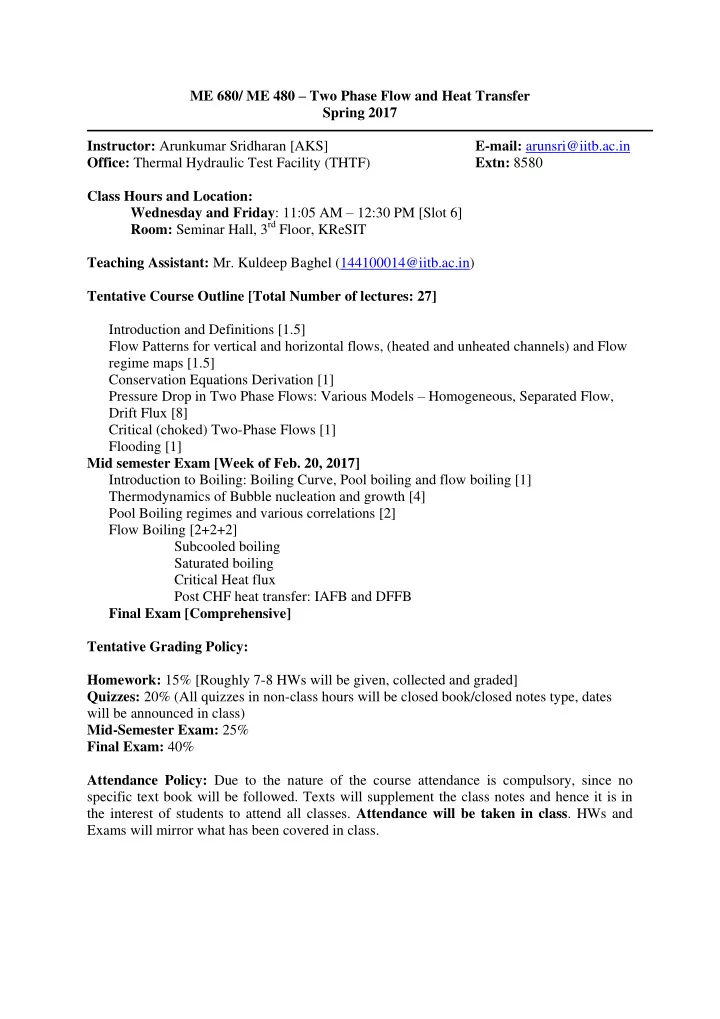

ME 680/ ME 480 – Two Phase Flow and Heat Transfer Spring 2017 Instructor: Arunkumar Sridharan [AKS] E-mail: arunsri@iitb.ac.in Office: Thermal Hydraulic Test Facility (THTF) Extn: 8580 Class Hours and Location: Wednesday and Friday : 11:05 AM – 12:30 PM [Slot 6] Room: Seminar Hall, 3 rd Floor, KReSIT Teaching Assistant: Mr. Kuldeep Baghel (144100014@iitb.ac.in) Tentative Course Outline [Total Number of lectures: 27] Introduction and Definitions [1.5] Flow Patterns for vertical and horizontal flows, (heated and unheated channels) and Flow regime maps [1.5] Conservation Equations Derivation [1] Pressure Drop in Two Phase Flows: Various Models – Homogeneous, Separated Flow, Drift Flux [8] Critical (choked) Two-Phase Flows [1] Flooding [1] Mid semester Exam [Week of Feb. 20, 2017] Introduction to Boiling: Boiling Curve, Pool boiling and flow boiling [1] Thermodynamics of Bubble nucleation and growth [4] Pool Boiling regimes and various correlations [2] Flow Boiling [2+2+2] Subcooled boiling Saturated boiling Critical Heat flux Post CHF heat transfer: IAFB and DFFB Final Exam [Comprehensive] Tentative Grading Policy: Homework: 15% [Roughly 7-8 HWs will be given, collected and graded] Quizzes: 20% (All quizzes in non-class hours will be closed book/closed notes type, dates will be announced in class) Mid-Semester Exam: 25% Final Exam: 40% Attendance Policy: Due to the nature of the course attendance is compulsory, since no specific text book will be followed. Texts will supplement the class notes and hence it is in the interest of students to attend all classes. Attendance will be taken in class . HWs and Exams will mirror what has been covered in class.
References: 1. One dimensional two-phase flows - Graham Wallis, McGraw Hill (1969). 2. Liquid – Vapor Phase Change Phenomena: An Introduction to the Thermophysics of Vaporization and Condensation Processes in Heat Transfer Equipment – Van P. Carey, Taylor and Francis (1992). 3. Convective Boiling and Condensation – John G. Collier and John R. Thome, Oxford Science Publications (1996). 4. Boiling, Condensation and Gas-Liquid Flow, - P. B. Whalley, Oxford Science Publications, 1987. 5. Boiling Heat Transfer and Two-phase Flow - L.S. Tong and Y.S. Tang, Taylor and Francis (1997). 6. Nuclear Systems 1 – Neil E. Todreas and Mujid S. Kazimi, Hemisphere Publishing Corporation (1990). Note: 1. Please turn off your cell phones during class. 2. Use of unfair means in assignments, exams and quizzes will warrant punitive action as per the Institute policy. 3. In view of the nature of the course, it is in your best interest to attend the lectures. 4. Homework will be assigned regularly and graded. You are allowed to work in groups but the final work should be your own. 5. No class will be held on 6 th January 2017, 10 th February 2017 and 5 th April 2017 due to travel. These will be compensated in Wed/Friday morning 8 AM slots after February first week.
Problem Solving Methodology As engineers, one is expected to solve problems in the real world and very often, our solutions are reviewed by peers and superiors. An organized solution allows others to quickly understand what has been done and the flow of thought. A statement about the method of solution may also be included for clarity. In this course, you are expected to solve all homework problems, quizzes, and exam problems following the Methodology discussed below. Homework problems that do not follow the Problem Solving Methodology will not be graded. Begin each problem on a new page. Do not write on the back of the page. Briefly state the problem; do not repeat the problem statement. Use appropriate symbols to list known quantities. Briefly state what is to be calculated. Draw a schematic of the physical system. If conservation laws are used, indicate the required control volume or control surface by dashed lines. Use arrows to represent appropriate processes on the schematic. List any simplifying assumptions that are made. Compile property values, constants and other values that may be needed in subsequent calculations. Reference the table number from where the values were obtained. If a graph is used, reference the figure number and the input and output parameter values. Solve all problems using variables . Before the final answer is obtained, indicate the full equation with all numerical values substituted. This is particularly important for checking the correctness of units. Give the final answer to three significant digits. Include appropriate units. A numerical answer without units is meaningless . Box the final answer. Discuss and comment on the result. This helps give a better physical understanding to the problem and the phenomenon involved. This is intended to help you think beyond ‘plugging and chugging’. It is important that the solution method is correct, coherent and systematic. This way, your thought process and understanding become clear to the reader. From Fundamentals of Heat and Mass Transfer by Frank P. Incropera and David P. DeWitt. Published by John Wiley and Sons: New York, 1990, pp. 22-23.
Recommend
More recommend